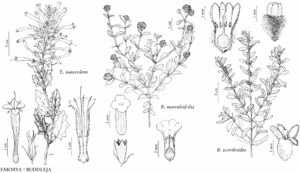Emorya suaveolens
in W. H. Emory, Rep. U.S. Mex. Bound. 2(1): 121, plate 36. 1859.
Plants to 2 m, older branches terete, younger ones subquadrangular. Stems much-branched; bark grayish or light brown, splitting. Leaves: petiole 5–10 mm; blade ovate-deltate, 2–7 × 1.3–4 cm, base hastate, margins irregularly cleft, slightly revolute, apex acute or obtuse, abaxial surface appressed stellate-tomentose, adaxial glabrate. Inflorescences 5–12 cm, cyme-bearing nodes 3–5, cymes 2 per node, subtended by small leaves proximally. Pedicels 2–5 mm; bracteoles 1–3, linear. Flowers slightly fragrant; calyx tomentulose externally, tube 5–7 mm, lobes marcescent, 4–6 mm; corolla puberulent externally, glabrous internally, tube 30–35 mm, 2–3 mm diam. at base, 4–5 mm in distal 1/2, lobes ± erect, 2.5–5 × 3–4 mm, apex rounded or obtuse; filaments flat, 15–20 mm, anthers slightly exserted or included, 2–2.5 × 1 mm; ovary conical, 5–7 mm, tomentulose; style filiform, 25–30 mm, surpassing stamens, stigma 0.5–0.6 mm. Capsules 10–12 × 3–4 mm, hairy, hairs stellate and glandular. Seeds 2–2.5 × 0.4–0.7 mm. 2n = 38.
Phenology: Flowering Jun–Oct; fruiting Jul–Nov.
Habitat: Limestone cliffs or canyons in chaparral with Juniperus, Quercus intricata, Fraxinus greggii, Senegalia berlandieri, and Nolina.
Elevation: 600–700 m.
Distribution
Tex., Mexico (Coahuila, Nuevo León).
Discussion
The exact location where Parry collected the type material for Emorya suaveolens is not known. The author believes that all of Parry's collections of Emorya are from one locality. Based on available collections from the area through which he traveled, the most likely locations are the canyons of Boquillas, Maravillas, or San Vincente.
In Mexico, Emorya suaveolens occurs at elevations to 2400 m.
Selected References
None.
